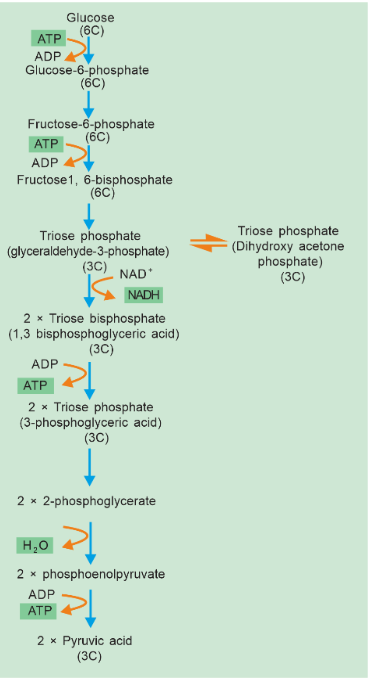Table of Contents
Glycolysis is a fundamental metabolic pathway that plays a central role in cellular energy production. It is the process by which glucose, a simple sugar, is converted into pyruvate, generating adenosine triphosphate (ATP) and NADH in the process.
What is glycolysis?
Glycolysis, derived from the Greek words “glycos” (meaning sugar) and “lysis” (meaning splitting), refers to the enzymatic breakdown of glucose into pyruvate. It is a metabolic pathway that occurs in the cytoplasm of both prokaryotic cells and eukaryotic cells, allowing to produce energy in the form of ATP.
The contributions of Gustav Embden, Otto Meyerhof, and Jakub Karol Parnas were instrumental in unraveling the intricacies of the glycolytic pathway, also known as the Embden-Meyerhof-Parnas (EMP) pathway.
Steps of glycolysis
Glycolysis, the Embden-Meyerhof-Parnas pathway, consists of a series of ten enzymatic steps that convert glucose into two molecules of pyruvate. Throughout these steps, there are specific reactions where ATP and NADH are produced. Let’s break down the steps of glycolysis.

Energy-Investment Phase
Step 1: Glucose phosphorylation
Glucose is phosphorylated by the enzyme hexokinase, utilizing one ATP molecule to form glucose-6-phosphate.
Step 2: Glucose-6-phosphate isomerization
Glucose-6-phosphate is converted into fructose-6-phosphate by the enzyme phosphoglucose isomerase.
Step 3: Phosphorylation of fructose-6-phosphate
Fructose-6-phosphate is phosphorylated by the enzyme phosphofructokinase-1, utilizing one ATP molecule to form fructose-1,6-bisphosphate.
At this point, we transition into the energy-payoff phase of glycolysis.
Energy-Payoff Phase
Step 4: Cleavage of fructose-1,6-bisphosphate
Fructose-1,6-bisphosphate is cleaved into two three-carbon molecules: glyceraldehyde-3-phosphate (G3P) and dihydroxyacetone phosphate (DHAP).
Step 5: Conversion of DHAP to G3P
The enzyme triose phosphate isomerase converts DHAP into G3P, resulting in two molecules of G3P.
Step 6: Oxidation and ATP production
Each molecule of G3P undergoes oxidation and phosphorylation by the enzyme glyceraldehyde-3-phosphate dehydrogenase (GAPDH), resulting in the formation of NADH and generating one ATP molecule per G3P. This step occurs twice since we have two molecules of G3P.
Step 7: Phosphorylation and ATP production
Each G3P molecule is phosphorylated by the enzyme phosphoglycerate kinase, leading to the formation of 1,3-bisphosphoglycerate and generating one ATP molecule per G3P. This step occurs twice. This step is the first substrate-level phosphorylation in the glycolytic pathway.
Step 8: Conversion of 1,3-bisphosphoglycerate to 3-phosphoglycerate
The enzyme phosphoglycerate mutase catalyzes the conversion of 1,3-bisphosphoglycerate to 3-phosphoglycerate.
Step 9: Conversion of 3-phosphoglycerate to 2-phosphoglycerate
The enzyme enolase facilitates the conversion of 3-phosphoglycerate to 2-phosphoglycerate.
Step 10: ATP production and pyruvate formation
The enzyme pyruvate kinase catalyzes the conversion of phosphoenolpyruvate (PEP) to pyruvate, generating one ATP molecule per PEP. This step occurs twice since we have two molecules of PEP. This step is the second substrate-level phosphorylation in the glycolytic pathway.
Throughout glycolysis, a total of four ATP molecules are produced (two in step 7 and two in step 10). Additionally, two molecules of NADH are generated in step 6.
Key Points about Glycolysis
- Glycolysis occurs in the cytoplasm and does not require oxygen (an anaerobic process).
- It is a universal pathway present in all living organisms.
- Glycolysis is the first step in both aerobic and anaerobic respiration.
- The net energy yield of glycolysis is two molecules of ATP.
- Glycolysis produces NADH, which can be further utilized in the electron transport chain for additional ATP production.
Significance of glycolysis
Glycolysis is significant as it provides a vital energy source, generating ATP, even without oxygen. It occurs universally, producing metabolic intermediates for cellular processes. Glycolysis regulates glucose levels and connects to other pathways like the citric acid cycle. Its disruption can lead to metabolic disorders. In cancer cells, glycolysis supports increased energy demands. Glycolysis is a fundamental metabolic pathway that plays a central role in energy production, nutrient utilization, and the generation of metabolic intermediates in cells.
Frequently asked questions
What is the significance of glycolysis in cellular metabolism?
Glycolysis is essential for energy production in the form of ATP. It provides a source of quick energy for cells and is a vital pathway in glucose metabolism.
Can glycolysis occur in the absence of oxygen?
Yes, glycolysis can occur in both the presence and absence of oxygen. In the absence of oxygen, the product of glycolysis, pyruvate, can undergo fermentation to generate additional ATP.
What happens to pyruvate produced during glycolysis?
Pyruvate can undergo further metabolic pathways, such as the citric acid cycle (Krebs cycle) in aerobic conditions, or fermentation in anaerobic conditions, depending on the availability of oxygen.
How is glycolysis regulated in cells?
Glycolysis is regulated by several enzymes and signaling pathways. Key regulatory points include the enzymes hexokinase, phosphofructokinase, and pyruvate kinase, which are subject to allosteric regulation and hormonal control.
Does glycolysis occur only in humans?
No, glycolysis occurs in all living organisms, including plants, animals, and microorganisms.







